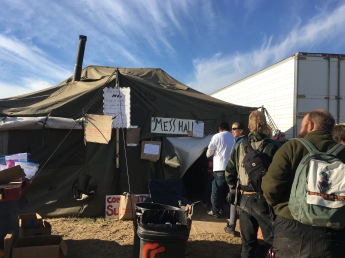
Meal line up outside the mess hall of the Main Kitchen. Photo by Elizabeth Hoover
Since April, thousands of Indigenous people and their allies have converged on the Standing Rock Indian Reservation and treaty lands, to support the Standing Rock Sioux Tribe in their opposition to the Dakota Access Pipeline (DAPL), slated to cross under the Missouri River directly upstream from the reservation. People have come from around the world to pray; to stand in opposition to Energy Transfer Partners and the Morton County Sheriff’s Department as well as 71 other law enforcement agencies; and to form community. Some people come for the weekend, others have quit their jobs and made resisting this pipeline their full time work. They spend their days building infrastructure at the camp, chopping wood, sorting donations, praying and singing at the main fire, and putting their bodies on the line between the land and an energy company determined to drill through it. So how do you keep thousands of water protectors consistently fed? Dedicated volunteers at the Oceti Sakowin Camp, the Sacred Stone Camp, and the Rosebud Camp, all clustered at the edge of the Cannonball River, spend hours a day focused on exactly that. There are now at least 13 kitchens at these three main camps, run completely by volunteers working with donated foods, feeding thousands of people three meals every day. At the Oceti Sakowin camp, these range from the Main Kitchen in the center of camp, which receives and stores most of the food donations, to other large kitchens like California (Grandma’s) Kitchen, All Relations (Lower Brule) kitchen and Winona’s kitchen which feed up to 600 people a day, to slightly smaller camp kitchens, like Pueblo Camp, Southwest Camp, Oglala (Wounded Knee) camp, and the Two Spirit camp. I had the opportunity to visit Oceti Sakowin from November 17-28, and to work in and visit some of these kitchens. I was amazed at the range of experience that people brought into this work– from professional chefs used to feeding thousands a day, to women once accustomed to feeding only their own families, to young people who needed to be taught basic knife skills– and the level of dedication to ensuring that three hot, nutritious meals a day are made available to everyone.
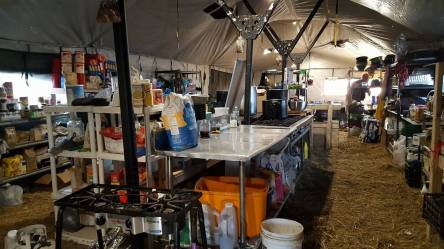
Inside the Main Kitchen. Photo by Brian Yazzie
I started out in the Main Kitchen, in the upper portion of Oceti Sakowin camp, since this is where my friend Chef Brian Yazzie had been working during his visits, and he wanted me to check and see how they were doing. I had already been warned about the vegan chef who had been running operations in there– something considered an anomaly at a camp that was supposed to be Indigenous-centered (as most people equate Indigenous Plains cuisine with meat). But by the time I arrived Conan, a vegan chef of Afro-Euro-Asian-Indigenous Caribbean ancestry from the Netherlands, had softened a little. I found him cooking bratwurst over the grill, describing how he’d had to relinquish some control over the kitchen and his usual methods of cooking, becuase people had been complaining about not getting enough meat. He described how he had once worked for a collective of vegan chefs, cooking in refugee camps in Greece for 8,000 people a day. He described the reactions of the refugees as similar to the Native people he was cooking for here. “They were like Indians, where’s the meat? You forgot the meat!” So each meal now included meat, in addition to a generous helping of vegetables. Lunch that day consisted of curried chick peas, rice, salad with organic mixed greens, roasted pumpkins, squash and zucchinis, and beef sloppy joes. While Conan moved around the tent, directing a constant flow of volunteers in an effort to get lunch out into the mess hall in some kind of timely fashion, a woman walked in and announced that a historic meeting of 100 chiefs was happening. They needed a traditional soup to feed them all. In one hour. Conan took a deep breath, turned to a pot of venison broth he had luckily already started on one of the burners, and set people to work chopping celery, carrots, and onions. In this way, through a constant series of improvisations, everyone is fed.
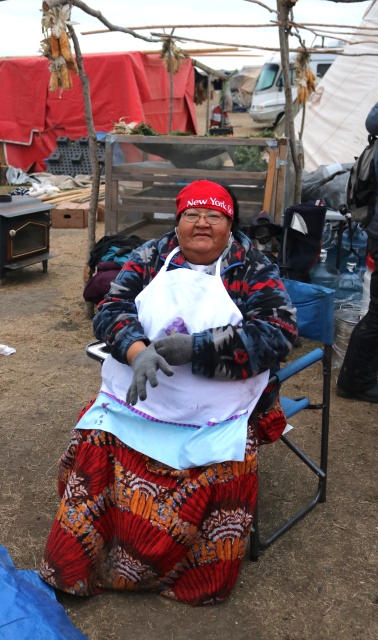
Winona Kasto, head of “Winona’s Kitchen.” Photo by Elizabeth Hoover
Since the founding of that Main Kitchen, other kitchens have split off, to serve their own style of cuisine or their own distinct communities. Winona Kasto, from the Cheyenne River Sioux Tribe, arrived at the Oceti Sakowin camp in August with a pup tent and two pairs of clothes, and has been back and forth ever since. Her kids are now enrolled in the local school in Cannon Ball, and she now calls a camper parked adjacent to the tents that make up her kitchen, home. Winona is a commanding presence– she is constantly wearing an apron and a smile, and is quick to put everyone around her to work. Which people are happy to do, in exchange for the food that she offers freely. She originally worked at the Main kitchen, but then broke off to start her own kitchen because people were complaining there wasn’t enough meat being served at the other kitchens, and she felt this was necessary to sustain people for the fight, and against the cold. Winona’s kitchen focuses on hearty stews, frybread, and other made-from-scratch stick-to-your rib dishes. Her kitchen has received donations from her tribe (Cheyenne River Sioux), as well as buffalo from the Northern Cheyenne Araphao tribe, and lots of eggs and potatoes from Organic Valley Farms. She describes how it took her three days to set up her kitchen– once she set her mind to do it, donations flowed in– everything from pots and pans to tents and tipis to stoves and equipment, to food. In the week and a half I was there, this camp and kitchen changed by the day, as new tents went up to house produce, dry goods, and a new dining hall.

Rachel (on the right) from All Relations Kitchen. Photo by Elizabeth Hoover
Another large kitchen, in the lower half of camp (to the north of flag road) is the All Relations (also known as Lower Brule) kitchen. Rachel, who works along side fellow head chef Maria in this kitchen, has been at Oceti Sakowin camp for two months. She started hosting people at her camp becuase she made such good campfire coffee. She described, “people would come to visit and we would offer them coffee or some stew if we had some, they liked it so well and they liked how our hospitality was, how we treated them and received them, which is part of our tradition. To be a good relative we receive people and welcome you. And if you’re hungry we feed you. Whatever we have, we can offer. and then after that– it started about 18 people that I was cooking for. I thought I would just be cooking for my camp and that was it, but after the coffee and all of the stews and the different dishes that i was making, people just started coming and it grew and grew and grew and grew until we got to about 600-700 people a day now.” She and her staff feed people out of a large army tent, serving everything from stews to macaroni salad and arroz con leche. “Everything in that kitchen I prayed for. The shelves, the pots, even the floors, extra storage. The meats, the foods.” People whose friends have eaten in her kitchen seek Rachel out, and she welcomes them all in. When I stopped back by the kitchen a few days later, the main concern of Maria, the other head chef, was having enough meat to feed the warriors in the camp (they had been hit by an onslaught of visitors over the Thanksgiving holiday), and where she was going to get the ingredients to make Christmas cookies– they had the oven to do so, but nobody had yet donated sprinkles or icing. This seemed important to her– ensuring some sort of normalcy for the camp for the impending holidays.
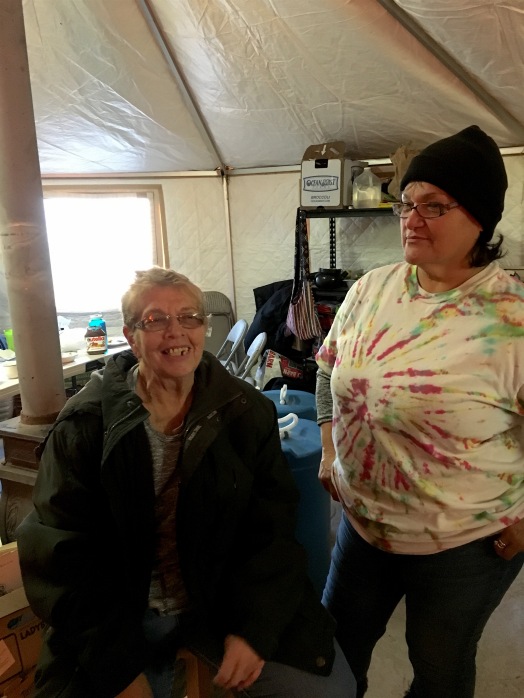
Diane Hart and Pat Joseph in the California Kitchen. Photo by Elizabeth Hoover
In another kitchen across camp, to the south of the Main Kitchen and just west of the giant geodome where community meetings are held, is the California Kitchen, also known to some as Grandma’s Kitchen, run by two Paiute ladies- Diane Hart (referred to affectionately by everyone at camp as Grandma Diane), and Pat Joseph. Diane is from Bishop Paiute tribe in California, and her tribe, as well as the Seven Council Fires, has provided much of the infrastructure for this camp. Everything else comes from donations, which were constantly streaming in the door. Diane is a tough grandma– she set up a kitchen and was cooking at the Treaty Camp when it was raided and torn apart by authorities. She retrieved what she could from the wreckage, although was disgusted to report that many of her things were torn apart and urinated on by police, and had to be discarded, and that one of her big tents was destroyed by a bulldozer. She gathered what was left and moved her kitchen back down to the Oceti Sakowin camp. They currently feed hundreds of people a day out of this kitchen, planning the menu on the fly each day depending on what meat is thawed and which donations have come in.
While fellow NAFSA board member Dan Cornelius and I were visiting Grandma Diane at the California kitchen, we spotted some ears of blue and white flint corn that someone had dropped off, but the kitchen hadn’t been able to utilize becuase it hadn’t been processed yet. Dan set to work pawing through it and pulling out a number of ears to prepare. We poured the shelled corn into a pot of hot water with baking soda–we would have preferred to use hard wood ash, but all of the fires at camp were burning mostly soft wood, so baking soda was a second choice of an alkaline material to loosen up the hulls of the flint corn and make it more digestible. The corn tells you it’s ready when it turns an orange color (see second photo from the right). We then rinsed the corn, and set it aside to add to a wild rice and hominy salad. We never got a photo of the finished product becuase we ran to the front lines of the action on the bridge on Sunday night (November 20), before the salad was finished. We were working in California kitchen when a man rushed in and declared all able bodied people needed to rush to the front lines because the camp was under attack. Most of the kitchen staff dropped our colanders and paring knives, and ran to the Backwater bridge, to spend the evening alongside hundreds of other protectors under a hail of rubber bullets, tear gas canisters, concussion grenades, and icy water.
But some did stay behind, to finish the meal, and make sure cold and injured water protectors had hot food to come back to. Grandma Diane had recounted the night that all of the Main Kitchen staff were arrested on the front lines, which then meant all of the other kitchens had to step up to feed everyone. Now to prevent this, she makes sure some stay behind to do the important work of keeping everyone fed.
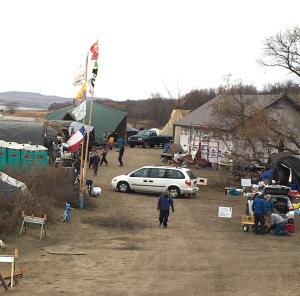
New kitchen being built at Sacred Stone camp. Photo by Elizabeth Hoover
All of these kitchens are powered through donations, some of which go directly to the individual kitchens, and many of which go directly to the Main Kitchen to be stored in the army tent pantries. By November, the white rice had formed its own mountain, along side bean mountain. Canned goods lined the walls and makeshift shelves inside the tent, sorted into loose categories– soups, vegetables, fruits, meats. Most of the food was good; some arrived years expired, or in unlabeled home canned jars with mysterious contents.
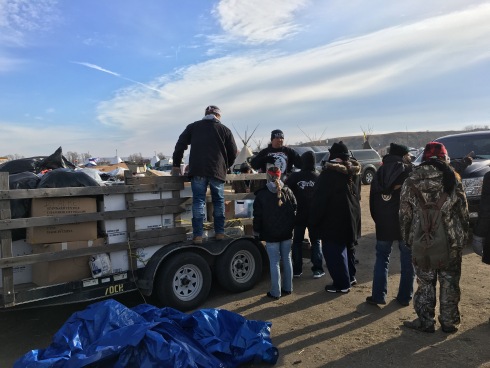
AIM chapter out of California delivering food supplies to the Main Kitchen. Photo by Elizabeth Hoover
Brian Yazzie, Chef de Cuisine with The Sioux Chef out of Minneapolis, arrived on Wednesday November 23 with his partner, Danielle Polk, and a 20 foot long U-Haul truck full of $40,000 worth of donations from organizations like the Organic Consumers Association, and gathered through a food drive at the First Universalist Church. Becuase Brian had cooked at the camp before, he knew what to bring. People came from various kitchens across camp to collect fresh fruit and produce, cooking pots and pans, cutting boards and knives, and other necessary camp supplies.
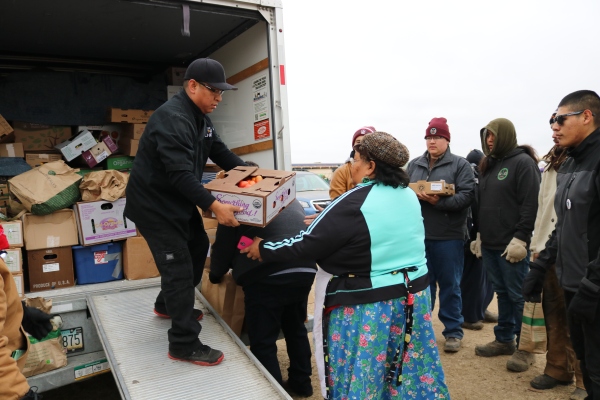
Brian Yazzie handing off produce to Winona. Photo by Elizabeth Hoover
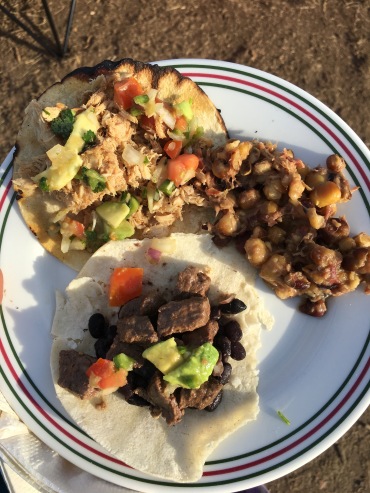
Shark meat and venison tacos made by chef Brian Yazzie. Shark meat from California was one of the more unusual food donations, along with 2,000 lbs of alpaca meat donated by a couple from Oregon, that Winona turned into stew. Photo by Elizabeth Hoover
In addition to much needed fresh produce, there have also been efforts to bring traditional indigenous foods to camp to feed water protectors. The Native American Food Sovereignty Alliance (NAFSA) raised funds to purchase hand harvested, hand parched wild rice, the “food that grows on water,” from the White Earth Nation in Minnesota, which Dan Cornelius then drove to Oceti Sakowin, and we then distributed to Winona’s Kitchen, Pueblo Camp, California Kitchen, Red Warrior Camp, and for Brian to cook with in Main Kitchen.
Traditional foods are considered an important tool in, and motivation for, winning this fight against polluting fossil fuels. Getting traditional foods into camp to keep morale up– whether that was enough buffalo meat in the stews across camp, or more tribally specific delicacies–food was important focus. For example Towana Yepa and the Pueblo Action Alliance sponsored a special fundraiser to bring more traditional Pueblo foods to camp so that the community members stationed there would be strong, and wouldn’t feel as homesick. “Many of our water protectors have been there for many weeks, some months, and a little taste from home can do wonders for our spirit….These food Items include but not limited to: Blue Corn flour, Posole- dried/frozen. Dried red chile, Green chile, Elk meat, Deer meat, Buffalo Meat, Tamales, Pueblo pies, Pueblo Cookies. Jemez Enchiladas-frozen,Oven Bread, pre-made tortillas and any other cultural foods you feel will feed their spirits.”
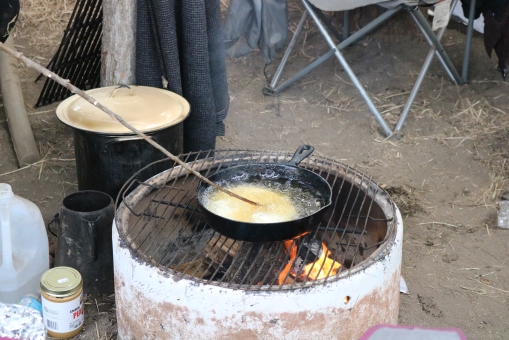
Frybread being made at Pueblo Camp. Photo by Elizabeth Hoover
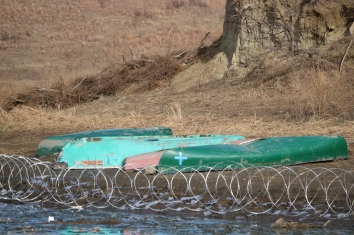
Lee’s ricing canoes, stolen by DAPL security and police, destroyed, and trapped behind razor wire. They were later rescued by a group of veterans, although they have been rendered unusable. Photo by Elizabeth Hoover
In addition to fueling bodies with traditional foods, the methods and tools used to procure them are being repurposed to the fight. Lee Sprague from Michigan described how wild rice canoes and ice fishing tents, and even his ricing canoe push pole, had been utilized to fight the oil company. Lee was temporarily stricken with grief when after an action on Turtle Island, DAPL security stole and destroyed his canoes that he had used for ricing. He lamented how those canoes had gone out hundreds of time to gather traditional foods, and were now intended for his daughters to learn this skill. Undeterred, the Cold Water Rescue Team is procuring new boats.
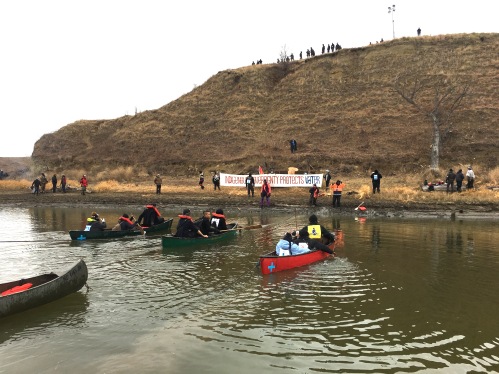
Canoes being used to ferry water protectors over to Turtle Island, the day before they were stolen and destroyed. Photo by Elizabeth Hoover
The action on Turtle Island was happening at the same time as Native chefs back at camp were coordinating an epic Thanksgiving dinner. Jane Fonda and Shaylene Woodley coordinated with cafe owner Judy Wicks to cater and serve dinner to water protectors at the Standing Rock High School. But Brian, and the ladies in the California Kitchen and Winona’s kitchen had their own plans, deciding to combine forces to serve an epic assortment of foods to more than 1,500 participants. People at the camp had mixed feelings about Thanksgiving. When friends and I told one Navajo woman that we were leaving the direct action to head back to the kitchens to help with cooking Thanksgiving dinner, she proclaimed to us that many people were fasting that day. Thanksgiving was a holiday that appropriated Native peoples and she refused to take part in it. She and others were going to have their big meal the next day instead. I had no compunctions at heading back to the kitchens—hundreds and hundreds of people DID want to eat that day, and the chefs were preparing anything but the typical Thanksgiving dinner. People were not celebrating a fabricated scene between Pilgrims and Indians, they were there celebrating life and unity, and praying for the protection of their camp and the water. Native elders, then women and children and then men were served first. Then non-Native people were invited into the dome to eat. Not everybody was happy about this arrangement—some ate hours after they expected to. But there wasn’t more than a mild grumbling– many aspects of the camp privilege Native people and perspectives first, and so visitors were expected to bear with this.
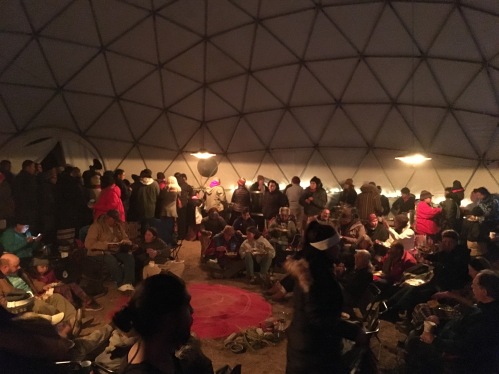
Thanksgiving Dinner in the geodome. Photo by Elizabeth Hoover
The chefs set up a temporary dining hall inside the 200-foot geodome ordinarily used for daily meetings. They lined up 17 eight foot long tables, piled them high with food, and served for over two and half hours. The chefs served the usual turkey, mashed potatoes, stuffing squash and cranberry sauce, but in addition served buffalo stew, hominy stew, bison hearts, venison, goose, duck, and shark meat. There were bean salads, maccaroni salads and green salads. There were also a number of wild rice dishes, cut up fruit, pies, and fry bread.

Serving Thanksgiving dinner inside the geodome. Photo by Brian Yazzie

Prayerful march to Turtle Island on Thanksgiving Day. Photo by Elizabeth Hoover
I want to conclude just by saying how I continue to be amazed with, and touched by these food providers. I was impressed by the humble confidence with which they prayed for everything that came into their kitchens– from food to supplies to volunteers to firewood. I was impressed with their generosity of time, spirit, and food. The determination with which they approached each morning and each meal. The absolute fierceness with which they loved each person who came into their kitchens, and each person who went to the front lines for this movement. On December 4th cheers erupted around the country when it was announced that the Army Corp of Engineers was denying DAPL a permit to drill under Lake Oahe. But many people at this camp, including the chefs, are skeptical and not packing up yet. Winona’s response to the news was “I’m not going anywhere! We are waiting for the pipelines to be taking out and DAPL is gone.” As I write, Winona is currently coordinating an emergency kitchen at the Casino Pavilion for people who are being evacuated from Oceti Sakowin during a blizzard. The movement continues.
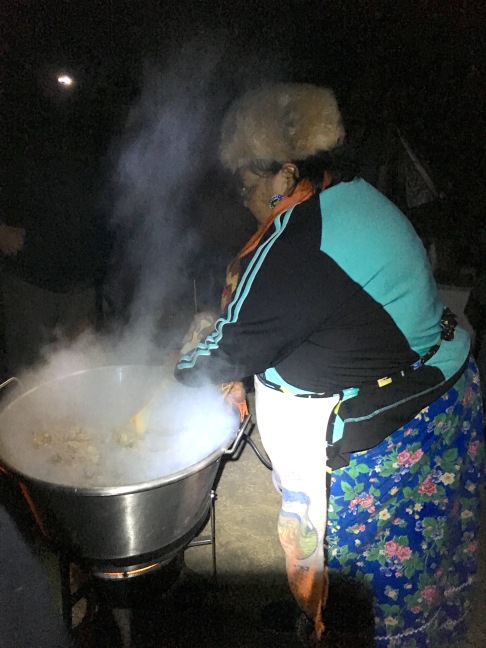
Winona Katso and her immense soup pot. On the evening of the Nov 20th bridge action, Winona was cooking soup until 3am, making sure that each cold and wet water protector who came back to camp had a hot meal. Photo by Elizabeth Hoover.




















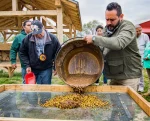
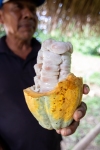

Good luck to your cause! And that’s an interesting bit about the different positions on Thanksgiving.
Thanksgiving meal at the Dome was aMazing and full of warmth and gentle spirit! Winona and all her cooks/help put out great hot soups and meat with huge portions for us..thank you all for your tireless efforts to share your love through your cooking and help to feed everyone’s hungry bellies 😙😙😙
Reblogged this on Kitchen Counter Culture and commented:
Chills of love and respect kept going down my spine reading this account of the kitchens at Standing Rock, from an activist-anthropologist-writer Liz Hoover, on a blog that is always insightful.
I very much enjoyed reading this, so thank you for this insight! 🙂